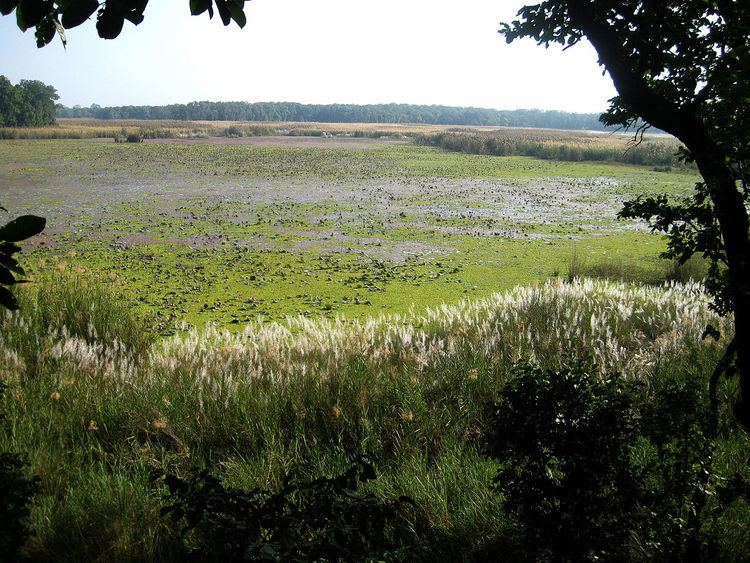Area 305 km² Phone +977 99-521309 | Address Mahakali, 10400, Nepal Established 1976 | |
 | ||
Governing body Department of National Parks and Wildlife Conservation, Ministry of Forests and Soil Conservation Similar Hotel Opera, Opera Hotel, Pilibhit Tiger Reserve, Mahendr Bus Station, Radio Mahakali | ||
The Shuklaphanta National Park is a protected area in the Terai of the Far-Western Region, Nepal, covering 305 km2 (118 sq mi) of open grassland, forests, riverbeds and tropical wetlands at an altitude of 174 to 1,386 m (571 to 4,547 ft). It was gazetted in 1976 as Royal Shuklaphanta Wildlife Reserve. A small part of the reserve extends north of the East-West Highway to create a corridor for seasonal migration of wildlife into the Sivalik Hills. The Syali River forms the eastern boundary southward to the international border with India, which demarcates the reserve’s southern and western boundary.
Contents
The Indian Tiger Reserve Kishanpur Wildlife Sanctuary is contiguous in the south; this coherent protected area of 439 km2 (169 sq mi) represents the Tiger Conservation Unit (TCU) Sukla Phanta-Kishanpur, which covers a 1.897 km2 (0.732 sq mi) block of alluvial grasslands and subtropical moist deciduous forests.
The protected area is part of the Terai-Duar savanna and grasslands ecoregion and is one of the best-conserved examples of floodplain grassland. It is included in the Terai Arc Landscape.
History
The area was a favorite hunting ground for Nepal's ruling class and was declared a Royal Hunting Reserve in 1969. In 1973, the area was gazetted as Royal Sukla Phanta Wildlife Reserve, initially comprising 155 km2 (60 sq mi), and extended to its present size in the late 1980s. A buffer zone of 243.5 km2 (94.0 sq mi) was added in May 2004. In 2017, the status of the protected area was changed to a national park.
The name Suklaphanta was derived from one of the grasslands found inside the protected area. The main grassland called Sukla Phanta is the largest patch of continuous grassland in Nepal covering an area of about 16 km2 (6.2 sq mi).
The jungles of the Shuklaphanta National Park were once the site of an ancient kingdom. To this day, ruins of that kingdom can be seen in some places. Near Rani Tal, a lake in the reserve, there still remains a brick girdle, measuring 1,500 m (59,000 in) in circumference. It is considered by locals to be a remnant of the fort of Tharu king Singpal.
Climate
The climate of the region is subtropical monsoonal with mean annual rainfall of 1,579 mm (62.2 in) that occurs from June to September and is highest in August. The winter months of December and January are fairly cold with daytime temperatures of 7–12 °C (45–54 °F) and occasional frost. From February onwards temperatures rise up to 25 °C (77 °F) in March and reach 42 °C (108 °F) by end of April. When the first pre-monsoon rains reach the area in May, humidity increases.
Vegetation
Some 700 species of flora are estimated in the park including 553 vascular plants, 18 pteridophytes, 410 dicots and 125 monocots. Grassland constitutes almost half the reserve's vegetation. The main grass species are Imperata cylindrica and Heteropogon contortus. khagra reed (Phragmites karka) and Saccharum spontaneum grow in the marshes surrounding the seven small lakes. The dominant forest type is sal. Khair and sissoo grow alongside rivers. Grassland encroachment by tree and shrub saplings are major threats to the long-term existence of the main phantas. Trees outcompete any grasses growing under them, especially those that need plenty of sunlight. Tree seeds are dispersed all over the grasslands and generally germinate near existing trees. Additionally, trees encourage the growth of shade-loving grasses and inhibit growth of sun-loving species. This process of succession usually converts grassland into woodland over time.
Fauna
The extensive open grasslands and wetlands around the lakes of the park are habitat for a wide range of fauna. In the rivers, lakes and ponds 28 fish species and 12 reptile and amphibian species were recorded. These include mahseer and rohu, mugger crocodile, Indian rock python, monitor lizard, Indian cobra, common krait and Oriental ratsnake.
Mammals
Current checklists include 46 mammal species, of which 18 are protected under CITES such as the Bengal tiger, Indian leopard, sloth bear, swamp deer, elephant and hispid hare. Great one-horned rhinoceros were translocated from Chitwan National Park to establish a third viable population in the country.
The congregation of swamp deer in the park's grasslands is the largest in the world; the population of hispid hare may be of international significance. As of 2013, there were 2170 swamp deer in the reserve.
Birds
A total of 423 bird species has been recorded. The park supports the highest population of Bengal floricans in Nepal. It is the western limit of swamp francolin, Jerdon's bushchat, rufous-rumped grassbird, chestnut-capped babbler and Jerdon's babbler; the north-western limit of yellow-eyed babbler; the eastern limit of Finn's weaver and the most important regular wintering site of Hodgson's bushchat. Forest birds include spot-bellied eagle owl, dusky eagle owl, rufous-bellied eagle and Oriental pied hornbill. The forests are also important for great slaty woodpecker and white-naped woodpecker. The white-rumped vulture, slender-billed vulture, lesser adjutant, grey-headed fish eagle, darter and rufous-rumped grassbird are breeding residents. Sarus crane, painted stork and bristled grassbird are summer visitors. Greater racquet-tailed drongo, white-capped water redstart, rusty-tailed flycatcher and rufous-gorgeted flycatcher are uncommon winter visitors.
During a survey carried out in January 2005, a total of 19 Hodgson's bushchats were recorded, and a year later only 8 males.
